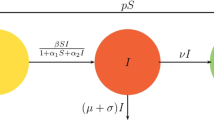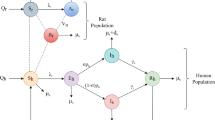Abstract
In this paper we consider the phenomenon of backward bifurcation in epidemic modelling illustrated by an extended model for Bovine Respiratory Syncytial Virus (BRSV) amongst cattle. In its simplest form, backward bifurcation in epidemic models usually implies the existence of two subcritical endemic equilibria for R 0 < 1, where R 0 is the basic reproductive number, and a unique supercritical endemic equilibrium for R 0 > 1. In our three-stage extended model we find that more complex bifurcation diagrams are possible. The paper starts with a review of some of the previous work on backward bifurcation then describes our three-stage model. We give equilibrium and stability results, and also provide some biological motivation for the model being studied. It is shown that backward bifurcation can occur in the three-stage model for small b, where b is the common per capita birth and death rate. We are able to classify the possible bifurcation diagrams. Some realistic numerical examples are discussed at the end of the paper, both for b small and for larger values of b.
Similar content being viewed by others
References
Castillo-Chavez C, Cooke K, Huang W, Levin SA (1989a) Results on the dynamics for models for the sexual transmission of the human immunodeficiency virus. Appl Math Lett 2: 327–331
Castillo-Chavez C, Cooke K, Huang W, Levin SA (1989b) The role of long incubation periods in the dynamics of HIV/AIDS. Part 2: Multiple group models. Mathematical and Statistical Approaches to AIDS Epidemiology. Lecture Notes in Biomathematics, vol 83. Springer, Heidelberg, pp 200–217
de Jong MCM, Kimman TG (1994) Experimental quantification of vaccine induced reduction in virus transmission. Vaccine 8: 761–766
de Jong MCM, Van der Poel WHM, Kramps JA, Brand A, Van Oirschot JT (1996) Persistence and recurrent outbreaks of bovine respiratory syncytial virus on dairy farms. Am J Vet Res 57: 628–633
Diekmann O, Heesterbeek JAP, Metz JAJ (1991) On the definition and computation of the basic reproduction ratio R 0 in models for infectious diseases in heterogeneous populations. J Math Biol 28: 365–382
Dushoff J (1996) Incorporating immunological ideas in epidemiological models. J Theor Biol 180: 181–187
Greenhalgh D, Diekmann O, de Jong MCM (2000) Subcritical endemic steady states in mathematical models for animal infections with incomplete immunity. Math Biosci 165: 1–25
Griffiths M (2007) Backward bifurcation and associated phenomena in epidemic models. PhD Thesis, University of Strathclyde
Gurney WSC, Tobia S, Watt G (1996) SOLVER: A programme template for initial value problems expressable as sets of coupled ordinary or delay differential equations. STAMS, University of Strathclyde
Hadeler KP, Castillo-Chavez C (1995) A core group model for disease transmission. Math Biosci 128: 41–55
Hadeler KP, van den Driessche P (1997) Backward bifurcation in epidemic control. Math Biosci 146: 15–35
Huang W, Cooke KL, Castillo-Chavez C (1992) Stability and bifurcation for a multiple-group model for the dynamics of HIV/AIDS transmission. SIAM J Appl Math 52: 835–854
Khan QJA, Greenhalgh D (1999) Hopf bifurcation in epidemic models with a time delay in vaccination. IMA J Math Appl Med Biol 16: 113–142
R Development Core Team (2004) R: A language and environment for statistical computing. R Foundation for Statistical Computing, Vienna, Austria. ISBN 3-900051-00-3, URL http://www.R-project.org
Sabó A, Blaškovič D (1970) Resistance of tonsillary and throat mucosa to re-infection with a homologous pseudorabies virus strain. Acta Virol 14: 17–24
Schweitzer AN, Anderson RM (1992) Dynamic interaction between CD4+ T-cells and parasitic helminths: Mathematical models of heterogeneity in outcome. Parasitology 105: 513–522
van den Driessche P, Watmough J (2000) A simple SIS epidemic model with a backward bifurcation. J Math Biol 40: 525–540
Varga RS (1962) Matrix iterative analysis. Prentice-Hall, Englewood Cliffs
Author information
Authors and Affiliations
Corresponding author
Rights and permissions
About this article
Cite this article
Greenhalgh, D., Griffiths, M. Backward bifurcation, equilibrium and stability phenomena in a three-stage extended BRSV epidemic model. J. Math. Biol. 59, 1–36 (2009). https://doi.org/10.1007/s00285-008-0206-y
Received:
Revised:
Published:
Issue Date:
DOI: https://doi.org/10.1007/s00285-008-0206-y
Keywords
- Backward bifurcation
- Equilibrium and stability analysis
- Basic reproduction ratio
- Simulation
- Three stage model
- Bovine Respiratory Syncytial Virus




